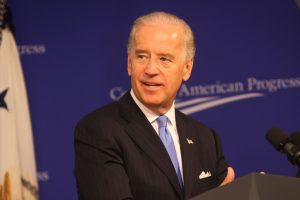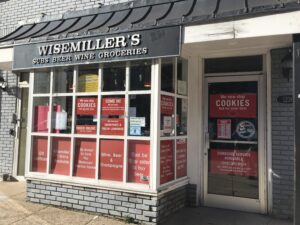This piece on the upcoming November election appears as part of our Alumni Speak column, featuring incisive, necessary commentary written by Georgetown alumni.
Planted right off of US-Highway 69, the Huntington Civic Center had clearly seen better days. Pine needles and cantankerous weeds littered the asphalt around the polling station while exposed concrete and ripped-up linoleum tiles greeted our feet. The uncovered floor was awaiting a decades-needed renovation. Setting down plastic tubs full of election and protective equipment, my co-worker, Ms. Ina Jane Thames, and I relished the sweet bliss of air-conditioning. After adjusting my N95 mask, I donned my plastic face shield and worried about what the day would bring.
Holding an election in the heat of July in Deep East Texas would have been a challenge in and of itself, but holding a Democratic Party primary runoff during a global pandemic, in a state that barred the use of mail-in ballots for able-bodied Texans under 65, seemed especially daunting.
Safety was our #1 priority—the day before we had fumigated the entire room with a “sanitization bomb” that smelled of oranges and hospital. We inspected the DS200 voting machine, logged the lock tabs, and hoped the big day would go off without a hitch. Every surface was sanitized. We turned off the lights, letting the sanitization bomb fumigate, and locked the door. Yet, in the back of my mind, uneasy concerns of the spreadability of COVID-19 in enclosed spaces remained.
Amidst the pandemic, elderly people have been hardest hit, meaning that poll workers, a job often dominated by senior retirees, would be placing themselves at risk. I felt a duty to help as a relatively young and healthy “low-risk” American. Such call, in addition to the need of some spare change and wanting to get a “behind-the-scenes” look at our democratic process, meant that I jumped when my local county Democratic Party asked for volunteers. As a recent college graduate who had only voted by mail, I would now be in charge of ensuring the security and soundness of our polls.
At 5 a.m. the next morning, I groggily shoved my mask, a few pens, a couple of granola bars, and a book into my bag. Half a dozen precincts spanning Angelina County had been combined and assigned to our small polling station; in the rural outskirts of Lufkin, Texas, Democrats were a rare breed. Those who would vote during a global pandemic in a primary runoff seemed non-existent. I made sure to bring an extra-thick book.
Forty minutes later, my rusty car sputtered into the parking lot of the Civic Center, everything still shrouded in darkness. Today was the day, I told myself as I mentally prepared for the 15-hour shift. We booted up the voting machines, sanitized the equipment, and prepped the dizzying array of forms, paperwork, and election paraphernalia. I adjusted the WiFi router. Ms. Ina Jane read through the instructions manual diligently. The sun cracked through the thin windows at the top of the building, and the whole county seemed to come to life as the highway began to roar with daily commuters. We were ready.
Behind my latex gloves, plastic face shield, and N95 respirator, I offered hand sanitizer spray to the first voter who walked in—right at 7 a.m. sharp—and directed him to Ms. Ina Jane. Our operation was precise, and contact was minimized at every turn. Once sanitized when they entered the door, the voter would then present their ID at the desk. Our new tablets could scan driver licenses while other forms of ID could be shown through a large clear plastic shield between the poll worker and the voter. A green check appeared on the tablet’s screen, the voter was approved, and a paper ballot was printed for them.
Once we handed over the paper ballot with gloved hands, the voter would be given a fresh stylus, wrapped in a plastic covering so that it could be handed to the voter without contact. Ballot and stylus in hand, the voter could then make their way over to the ExpressVote machine where they inserted the slip of paper and used the stylus to touch the screen of candidates. Once the voter made their selections, the slip of paper shot back out, and they inserted their paper ballot into the DS200 ballot counter. Both a digital and physical record were produced. Easy, simple, sanitary.
After the polls were open for 12 hours, I placed an old insurance card, now a makeshift bookmark, into my book, only a few chapters from the end; we officially closed our doors, printed machine reports, and followed the complex array of checks, balances, verifications, signatures, and cross-checks. Fumigation Round Two. This one smelled of peaches and medicine.
We delivered the physical paper ballots for record-keeping purposes to the Angelina County Courthouse Annex at 9 p.m., and local prisoners offloaded the voting equipment from the cars. Our sealed blue box of ballot contained 18 ballots. The winning candidate had an average of five more votes per precinct than her opponent. So many of our elections are won or lost by these minuscule margins; in fact, Donald Trump won the presidency by only 80,000 votes across three states. The upcoming election will be decided by one factor alone: turnout.
The protocols in place worked for our small election, with only 1-2 voters per hour. However, much higher turnout in November will complicate that, especially with the convergence of voters from all parties. Urban areas will be particularly hard-hit.
Coronavirus is unlikely to go away anytime soon, and the upcoming election will be one of the most contested in recent history. To lower the risk of exposure to the virus, many are turning towards mail. However, mistrust of an attempted slowdown in the U.S. Postal Service and the Republican track record of limiting polling locations in predominantly Black and POC areas have dwindled much remaining trust in a free and fair election. Additionally, many states do not consider the fear of contracting COVID-19 to be a valid excuse to vote-by-mail, a restriction affecting 55 million people.
As a poll worker, I can say that we made voting as safe as possible, following all state health and CDC guidelines and then some; yet, higher volume in November means that voters may have to wait longer as machines are cleaned. Long delays will be exacerbated further, especially if tensions rise over individuals who refuse to wear masks. Socially distant lines will stretch blocks rather than just meters outside. The implications will disproportionately impact voters of color, who often live in areas with limited polling locations and are more likely to have work schedules that conflict with the hours that the polls are open. The recent primary in Georgia had lines up to three hours long with majority-Black areas being the hardest hit. The effects of the pandemic could artificially skew results, depress turnouts, and challenge our very faith in the integrity of our electoral system.
We need to take steps now to alleviate these concerns, starting from an individual level. If you can, vote by mail early. Call to make sure your ballot was counted. If you cannot vote by mail, show up to the polls with a mask and be ready to wait longer than usual; create a plan now. If you’re young and otherwise low-risk, apply to be a poll worker; pay is often above minimum wage, and the job is most often filled by high-risk groups such as retirees.
States and local counties should ensure that they are properly stocked with personal protective equipment and sanitization materials and should have numerous mitigation and contingency plans in place. One option is hiring more poll workers and expanding curbside voting where poll workers can bring a ballot to anyone unwilling to enter the polling station building. This would allow for the handling of lines in and outside of the polling station and significantly reduce contact.
Additionally, early voting should be extended by several weeks to accommodate and space out voters, and the number of polling locations should be significantly increased. This extension would allow more flexibility for people with difficult job schedules and would prevent the nightmare scenarios we’ve seen in several states with hours-long lines. Particularly, increasing polling locations would help to alleviate the Black-white gap in voting times in which Black voters wait 29 percent longer than their white counterparts to cast their ballot. With party affiliation heavily determined by race and location, fair access to the ballot is critical to an accurate electoral outcome—not to mention a democratic value in and of itself. These are reforms that should happen every election but are especially salient under pandemic conditions when Black and Latinx communities have been the hardest hit.
Of course, these reforms are still a band-aid, and voting alone is no silver bullet nor panacea to the deep structural issues facing our country. Such issues will need the combination of external pressure and internal maneuvering. However, if Americans still believe in democratic values and in the ideal of universal suffrage, this upcoming election must be safeguarded. I hope we are up for the task.
At the end of my shift, I ripped off my mask and greedily heaved in the humid, 90-degree air. Finally, I thought. I rubbed my nose and cheekbones now sore from 15 hours under the stiff respirator. A red indent across my face served as my “I Voted” sticker for the day. A worthy prize. As the cicadas loudly sang their nighttime hymns, I watched Ms. Ina Jane waltz back towards her car and de-mask herself as well.
“See you in November!” She shouted across the asphalt.
“See you in November,” I said. I looked around at the Civic Center and prayed we were up for it.





